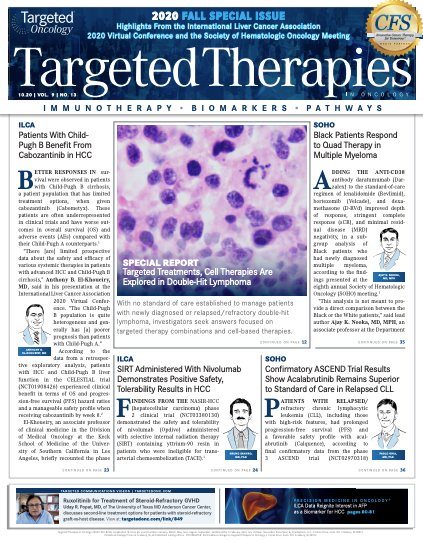SIRT Administered With Nivolumab Demonstrates Positive Safety, Tolerability Results in HCC
Findings from the NASIR-HCC phase 2 clinical trial demonstrated the safety and tolerability of nivolumab administered with selective internal radiation therapy containing yttrium-90 resin in patients who were ineligible for transarterial chemoembolization.
Bruno Sangro, MD, PhD

Findings from the NASIR-HCC (hepatocellular carcinoma) phase 2 clinical trial (NCT03380130) demonstrated the safety and tolerability of nivolumab (Opdivo) administered with selective internal radiation therapy (SIRT) containing yttrium-90 resin in patients who were ineligible for transarterial chemoembolization (TACE).1
“NASIR-HCC combined these 2 therapies for the treatment of patients who were not candidates for locoregional therapy,” said senior author Bruno Sangro, MD, PhD, director of the Liver Unit at Clínica Universidad de Navarra and a professor of medicine at the Clínica Universidad de Navarra School of Medicine in Pamplona, Spain, during his presentation of the data at the International Liver Cancer Association (ILCA) 2020 Virtual Conference.
After a median follow-up of nearly 16 months, 11% of patients reported a complete response and 26.2% had a partial response. The objective response rate (ORR) in 42 patients was 38.1%, and the disease control rate (DCR) was 81.0% (TABLE).1 Investigators reported that median time to progression was 9.0 months (95% CI, 7.84-10.15) and median overall survival (OS) was 20.69 months (95% CI, 17.38-24.01), with a 12-month OS rate of 73.7% and an 18-month OS rate of 61.3%.
Patients with intermediate-stage or advanced-stage HCC have limited therapeutic options, but the mainstay of treatment is intraarterial therapies, Sangro said. Nivolumab stimulates T-cell activity by blocking the PD-1 receptor and has shown significant antitumor activity for advanced-stage HCC. It is also approved in several countries, including the United States, as a second-line therapy.2
The trial was carried out in 9 academic hospitals in Spain. Eligible patients for NASIR-HCC had to have an unequivocal diagnosis of unresectable HCC confirmed by histology or imaging. Patients had to be ineligible for chemoembolization because of a single tumor larger than 5 cm, multiple tumors in the Barcelona Clinic Liver Cancer–B2 substage, or 90% of unilobar tumors with segmental or lobar portal vein thrombosis.
Initially, patients received SIR-Spheres that contained Y90 resin microspheres and 3 weeks later, they received 240 mg of nivolumab every 2 weeks. The primary end point was safety, and the secondary end point was antitumor activity as determined by ORR, DCR, duration of response, time to progression, progression-free survival, and progression pattern by RECIST 1.1. Exploratory end points included OS, albumin-bilirubin grade, and biomarkers, which were not discussed in the presentation.

Sangro reported that 54 patients were screened, with 43 patients evaluated to receive SIRT. Forty-two patients were treated with SIRT, and 41 patients received at least 1 dose of nivolumab.
Median age of patients was 65 years (range, 49-79). Prior treatments included TACE (21.4%), resection (16.7%), ablation (14.3%), and sorafenib (Nexavar; 11.9%). Nine patients (21.4%) had hepatitis C virus etiology, and 1 patient (2.4%) had hepatitis B virus. Thirty-two (76.2%) patients were uninfected.
Regarding SIRT treatment characteristics, the majority of patients had either 1 or 2 macroaggregated albumin injection sites, with 38.1% having 1 site and 50.0% having 2 sites. Only 11.9% of patients had 3 injection sites.
Sangro said that 15 patients (35.7%) completed treatment with nivolumab. “Ten patients continued on nivolumab after the study because they experienced disease control or objective remissions,” he added.
The main reasons for nivolumab discontinuation were tumor progression (40.5%) or toxicity (11.9%). Out of 26 events of progression, intrahepatic progression was reported in 53.5% of patients and extrahepatic progression was reported in 38.5%; 7.7% had both patterns of progression.
Regarding safety, the majority of adverse effects (AEs) of any causality were grade 1 (67.4%) or 2 (23.4%) in severity. Sangro said that 6.3% of patients temporarily discontinued nivolumab treatment as a result of AEs, but the majority (93.7%) took no action.
Thirty-eight percent of patients reported all-grade treatment-related AEs (TRAEs), and 11.9% reported grade 3 or 4 TRAEs. One (2.3%) patient reported a TRAE impeding nivolumab administration, and 1 patient had a TRAE leading to permanent discontinuation of nivolumab. Five (11.9%) patients required systemic steroids.
Immune-mediated AEs were typical of those observed in studies involving single-arm anti– PD-1 therapies, Sangro said.
“In this phase 2 trial, patients with HCC treated with resin microspheres and nivolumab showed a favorable safety profile with no signs of synergistic toxicity,” said Sangro. “Importantly, encouraging efficacy data were observed that warrant further evaluation in controlled trials.”
References:
1. De La Torre M, Matilla A, Varela M, et al. Nivolumab after selective internal radiation therapy using sir spheres resin microspheres in patients with hepatocellular carcinoma: the NASIR HCC trial. Presented at: International Liver Cancer Association 2020 Virtual Conference; September 11-13, 2020.
2. FDA grants accelerated approval to nivolumab for HCC previously treated with sorafenib. FDA. September 22, 2017. Accessed September 15, 2020. https://bit.ly/3moHi4q
